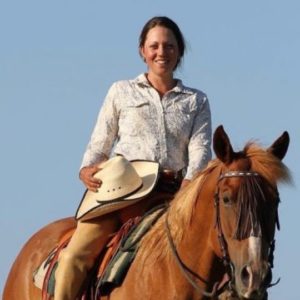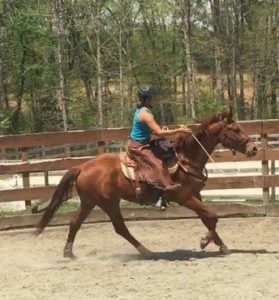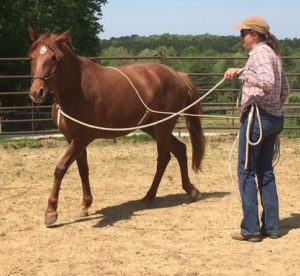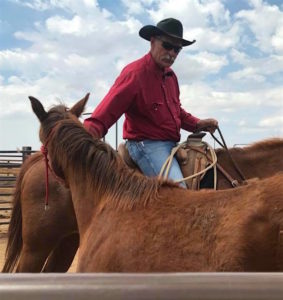 Editor’s Note: Amy Skinner is a regular guest columnist and has been a horse gal since age six. She will present an arena demonstration with fellow trainer and rider, Katrin Silva, at the Best Horse Practices Summit.
Editor’s Note: Amy Skinner is a regular guest columnist and has been a horse gal since age six. She will present an arena demonstration with fellow trainer and rider, Katrin Silva, at the Best Horse Practices Summit.
She rides and teaches dressage and Western. Skinner has studied at the Royal Andalusian School of Equestrian Art in Spain, with Buck Brannaman, Leslie Desmond, Brent Graef, and many others.
Skinner writes:
Lately, I’ve asked myself: What do I really know? And does it really work for the horse?
After long doses of reflection and experimentation, I’ve changed my training practices. Here’s what I’m finding:
 There are plenty of ways to “get things done” and there can be plenty of pressure to rush a horse. Having trained for the public for a decade now, I’ve worked with thousands of horses. That’s thousands of opportunities for me to learn from a horse and for them to tell me what does and doesn’t work. I’m a big proponent of listening to horses first, a silver-lining consequence of listening to people before horses for too long.
There are plenty of ways to “get things done” and there can be plenty of pressure to rush a horse. Having trained for the public for a decade now, I’ve worked with thousands of horses. That’s thousands of opportunities for me to learn from a horse and for them to tell me what does and doesn’t work. I’m a big proponent of listening to horses first, a silver-lining consequence of listening to people before horses for too long.
I’ve seen too many horses get the losing end of a deal when it comes to training. Trainers trying to prove they can turn a horse around faster than others, or take a bronc-ier horse than others. I’ve seen horses flipped over, injured, scared, run off, and lose confidence more every day. Rushed training – in which horses flip over, get hurt, scared, or lose their confidence – is more about boosting the trainers’ ego than helping the horse. Yet, “I can’t put a time limit on helping this horse” is an unpopular answer and trainers fear they will lose business. As one trainer told me: “Time is money. The client wants results. If we don’t get it done, they’re gonna take it somewhere else to someone who will do worse.” To me, this reaction is unacceptable. As trainers purporting to be “in it for the horse,” we simply must do better.

Young horse starting with Brent Graef
This spring, at the Brent Graef’s Young Horse Handling Class, I visited with Brent and his wife, Kris, about training time. Brent halter-starts yearlings from the Singleton ranch and later helps start the same colts as two-year olds. The Singleton Ranch is one of the largest ranches in the country, producing many high money earners in the NCHA.
Here’s part of our conversation:
Brent: How does this work compare to what you’re used to? (Referring to the smoothness of the unperterbed yearlings).
Amy: Well, it’s a lot quieter. I’m used to a lot more feathers flying. As a colt starter, I’ve been told I need to ride a buck better, or get a real cowboy to do it
Brent: some colt starters are bronc riders and they’re using the colts for bronc riding practice. That’s not the kind of person I’d like to ride my colt. I’d like them to not buck, they don’t need to do that. That’s the first thing I tell the guys at the Singleton’s– they’ll have new people that are coming in that are cowboys. I’ll say we’re gonna try to keep them out of trouble. We’re not here to make them buck, if you start making them buck, you’re out. Real simple deal.
Amy: If somebody asks you how long halter starting takes, or how long starting a colt takes, or how long it takes to fix xyz problem, how do you answer that question?
Brent: When I was starting them for the public, we got 30 days. Some of them would stay for 60, but we could usually only get paid for 30. You could expect 15-20 rides. That’s what you’ll probably get. It’s not like you’ll have a grandkid horse in that time.

Brent Graef
Each person has different skills, and it could take longer or shorter depending on those, and your set up, and how much time you have in a day. There’s really not a how long it takes. You can’t just define it by saying this is how long it is, it’s until it’s done.
Amy: So do you charge the same fee for troubled horses as you do other ones?
Brent: I don’t take troubled horses. I used to. But I’d tell people they were looking at at least a 4-6 month deal. But now we just take halter starting horses.
Amy: So how do you get around time constraint expectations with your clients?
Brent: No matter how long it takes we charge a flat fee. And we have a money back guarantee, if you don’t like our work you don’t pay.
Amy: And how do you manage the fact that your training horses are going to be one way with you and another with your clients?
Brent: Well, that’s what led to the clinics. When I’d take in a problem horse, I’d fix it up and send it home. The people would bring it back in a couple months with the same problem, and I’d think, that was fixed! So I’d fix it up again. It took me a little while to realize it’s not the horse causing the problem. So with the colts, they’d have to come ride with me, and with a problem horse, they’d have to come ride with me more than with a colt. I’d show them things that were causing the problems and tell them they had to quit doing that.
Kris Graef: Some people say quick colt starting isn’t good for the horse, but it depends. It may be bad, it may not be. It depends on how you do it. You don’t want the horse to get bored, you don’t want certain personalities to take over. It goes faster with a good set up, and being able to ride your colts in a group is a huge advantage.
Amy: Doing it quickly with good preparation is not the same as doing it quickly, and I think that’s something the public doesn’t always get to see. Thanks for the great answers.
Brent: You bet.
